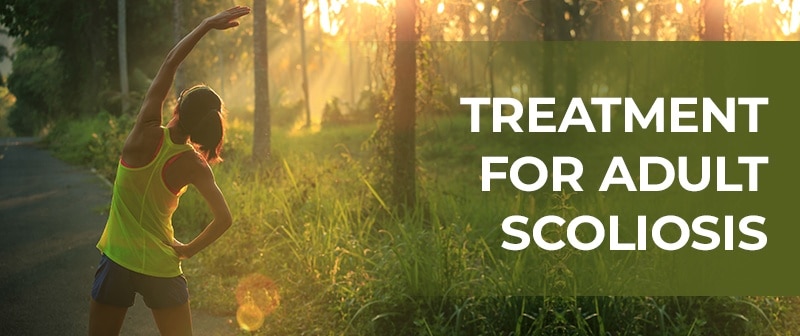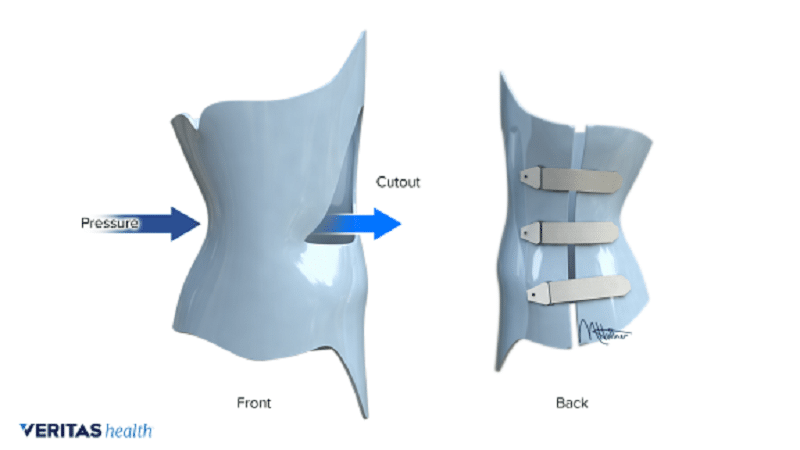
Adult scoliosis can be a debilitating and painful affliction. Proper treatment is essential, as any delay in stabilizing a progressively deteriorating abnormal curvature of the spine can lead to a lifetime of pain and limited mobility.
So, how is adult scoliosis treated?
The rest of this article will cover some essential topics and questions related to treating adult scoliosis:
There are two primary types of scoliosis:
Adult degenerative scoliosis is a more complex condition than adolescent scoliosis found in the adult. However, both types of adult scoliosis can be helped through treatment and dedication.
Adolescent scoliosis never goes away.
Simply 'growing out of it' isn't possible, unfortunately. Instead, the parents of children with childhood scoliosis must find ways to treat the problem before it gets worse. The need for urgent treatment exists because as a child with scoliosis reaches puberty, the growth of their spine can accelerate the curvature at a rapid pace.

When this curvature goes untreated or forgotten, it can become painful and debilitating as the patient ages. This curve progression in the adult often leads to moderate to severe pain and an inability to perform normal daily functions. The truth is, had the patient managed to get the situation under control earlier in life, they wouldn't be in such bad shape.
ADS most commonly starts when a spinal disc begins to deteriorate. Other common causes of adult de novo scoliosis include osteoporosis and pelvic tilting.
This deterioration can cause the spine to slowly become unstable and tilt into a scoliosis. This can cause strong pain, posture shifting, and loss of height that can best be handled through modern specific scoliosis exercise treatment.
Most cases of ADS include a spinal curvature of 30 degrees or less at the time of diagnosis. However, it is possible to see curves dramatically over that mark.
Even though cases of 30-degree curves fall into the moderate category, cases of moderate ADS that go untreated can eventually reach over 40 degrees of curvature and become severe. Progression of ADS is typically in the range of 0.5 to 3 degrees per year. Over a 10 or 20 year period, this can add up to a huge curve size.
Most people with ASA don’t experience any disability or pain until they hit their 30s, or possibly not until they arrive at their 50s. With an increase in spinal curvature of about one degree per year, most spines don’t progress to the point of constant pain or restriction of movement until this age range.
Adults with ASA in the 50-60 age range will experience more rapid debilitation, as the spinal curve progresses at a faster rate. This increased rate of degeneration is similar to the curve progression that ADS patients encounter.
Fortunately, ASA can be successfully treated with a customized program of scoliosis specific exercises. And while there are many scoliosis exercise programs with which ASA patients have seen success, the work of the CLEAR Scoliosis Institute is unique.
While a back brace is not the first form of treatment that typically comes to mind for adults with scoliosis, new research has validated its use. Just like we now see bracing for adults' teeth where we never saw it in the past, scoliosis bracing for adults is an excellent accompaniment to the exercise programs for adults scoliosis.
It's a great idea; modern adult braces are comfortable, relieving pain quickly, and can effectively slow or stop progression of the curvature. However, beware of cheap, old technology braces that often worsen the case if they're not designed specifically for the patient. Modern braces, such as a ScoliBrace, are much more effective at treating scoliosis.
Modern scoliosis braces are only indicated in approximately 30% of adult scoliosis cases; the other 70% can be effectively treated with custom scoliosis exercises. Bracing is never meant to be used without an accompanying scoliosis-specific exercise program that has been custom designed for the patient.
Scoliosis experts recommend two types of back brace: a hard brace and a soft brace. Each type has its pros and cons.
Plastic braces for scoliosis take a week or two to get used to. However, they grow more comfortable after the initial break-in period.
It usually takes some time for a person to get accustomed to wearing their plastic back brace, as it feels unnatural. That being said, it's not rare to find people who want to do everything, including sleep, while wearing their brace after the first few weeks.

Another reason that many people prefer hard braces is that they're custom-designed for each patient. This custom design means that they're made for your exact body size and shape. Think of it as a custom made piece of clothing… you would expect it to fit perfectly! A LASER is used to create a perfect replica of the patient's torso.
Plastic back braces are more expensive, but they're able to more effectively halt progression, give pain control, and improve posture.
The resulting decrease in pain and increase in function eventually convinces patients to stick with it long enough for the brace to become not just OK, but actually VERY comfortable.
Soft braces for scoliosis are more comfortable at the outset. Patients will often feel comfortable wearing one right away, as there isn't much of a movement restriction or limitation.
They also usually provide seemingly immediate relief because they lift the person into a better posture and support the weakened areas of the spine.
There are only two real problems with getting a soft back brace for scoliosis:
If a brace is deemed necessary by a scoliosis clinician, most patients are required to wear it for about 4 to 6 hours per day for pain control, but up to 20 hours per day if the patient is seeking reduction of their curve size. This number is an average estimate, and your scoliosis specialist will have an in-depth discussion with you to determine your goals and provide realistic expectations to arrive at an appropriate wear time for you.
Initially, you will visit the doctor more frequently to develop your customized home program. After the program has been developed, you will perform your exercises at home. Our whole approach is to empower the patient to self-treat. Yes, it is preferred that the patient be seen by a scoliosis specialist for their spinal maintenance, but the bulk of the scoliosis program is done through home exercises.
Depending on the severity of the case, you can expect to attend the office 10 to 15 times for your program development. In more severe circumstances, this number can stretch to 25 visits.
After going through the initial cycle of training on your customized exercises, adjustments, and other treatments, doctor visits are reduced to 'as needed.'
However, if the patient hasn’t attended in a while and cosmetic issues like a shoulder or hip tilt are coming back, or if the pain is returning, they will want to schedule an appointment for an updated evaluation and treatment plan. A new visit is often necessary after a year of non-treatment.

Patients who are physically fit tend to notice quicker, better results than those who are not. For this reason, the patient should perform regular “fitness” type exercises. This can really be any type of exercise, as long as it is not high impact or involves a lot of twisting movements.
Note: Adults with scoliosis should avoid anything that requires twisting, heavy-lifting, or running for long distances. However, many yoga poses (yoga for scoliosis) and light weight-lifting are completely fine.
Getting through the treatment process for scoliosis in adult patients isn't a cakewalk. It's an active program that requires consistent dedication to see the desired results.
There's good news, though. If patients follow through with these customized exercises and required treatments, they almost always achieve the four key goals of their treatment:
Diet generally isn't much of a factor, outside of remaining healthy for the treatment process.
However, some scoliosis experts suggest supplements and food choices that improve bone and joint health.
Inflammation and swelling are also issues associated with scoliosis, which is why many scoliosis experts recommend a modified scoliosis specific diet and supplements that reduce both problems.
There are two primary types of scoliosis that presents in adults: Adolescent Scoliosis in the Adult (ASA) and Adult Degenerative Scoliosis (ADS).
ASA first exhibits during a patient’s teenage years and can become debilitating at any point between the ages of 30 and 50. ADS usually starts presenting at age 50, but is often associated with an untreated case of pediatric scoliosis.
Proper treatment of adult scoliosis is essential. Whether it's caused by an untreated case of juvenile scoliosis or the onset of ADS, sufferers must do whatever they can to halt and fix their spine's curvature issues.
Fortunately, almost all cases of adult scoliosis are treatable with proper scoliosis specific exercises, focused chiropractic adjustments, and occasionally selected bracing.
If you are going to try bracing, make sure you talk to your scoliosis specialist before purchasing a brace. You need to be sure that the brace you’re buying will actually be beneficial to your unique situation. Also, bracing should never be used as the sole means of scoliosis treatment - it should always be used in conjunction with a scoliosis exercise program designed specifically for the patient.
Scoliosis patients will likely need to visit the doctor anywhere between 10 and 25 times over the course of the development of their exercise program. Once the patient is comfortable with the routine, the doctor can reduce the visit frequency to “as-needed.”
Whatever your age or situation, if you are (or think you are) suffering from scoliosis, scheduling an appointment with a professional who specializes in non-surgical scoliosis care programs should be a top priority. Scoliosis can be managed best when it’s caught earlier. The longer you wait to treat it, the more difficult the treatment process becomes.
“The author’s views are his or her own and may not reflect the views of CLEAR Scoliosis Institute.”

CLEAR provides a unique and innovative way of understanding scoliosis. Sign up to receive facts and information you won’t find anywhere else.

Dr.Andrew Strauss, My name is June Webster, I am 87 yrs old and I just found out I have Scoliosis after years of pain, leg swelling, leg turning red, cannot stand for long but no one looked for a problem so here I am one person ignored and suffering all these years. Is there any help for me? I Would like to know if there is some help for me?
Hello. I am a 46 year old female from Korea. Currently I have 95 degree scoliosis.
At the age of 11, scoliosis was discovered, and the brace was worn for about 3 years, and the angle was about 50 degrees, so the doctor recommended surgery, but did not. No hospital visits since.
I was recommended to have surgery after going to the hospital this year, and I made an appointment for surgery in November.
My condition is almost painless and I have some shortness of breath when moving. Actually, I don't want to have surgery as much as possible.
Dr. I'd like to hear from Andrew Strauss, so I'm contacting you.
Will adult braces and exercise help me? Or do I need to have surgery?
Please note that there are no adult braces in Korea.
thank you.
Hello, Eunkyoung,
Please email your most recent x-rays to Dr. Strauss at [email protected]. Once he sees them, he'll be able to advise you.
Dear Dr. Strauss,
I was diagnosed with scoliosis when I was 15.
I wore a hard brace for a while.
I am now 71 and very active.
I also have osteoporosis and take prolio shots every 6 months.
I would like to know what would be the best exercise plan for me going forward to prevent pain.
I’m concerned about getting enough cardio and weight training.
If you can also maybe recommend someone I could see in the Sacramento, California area.
A chiropractor, physical therapist, trainer?
Thank you for your time,
Hello, Ms. Turpin. Congratulations on managing your condition so well. One of your first statements is really the best thing to do, stay very active! As far as specifics of your case are concerned, the best thing to do is find the CLEAR certified doctor closest to you. You can locate them here.